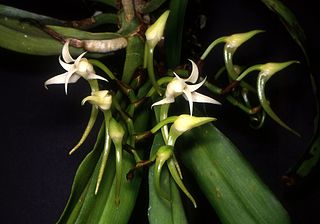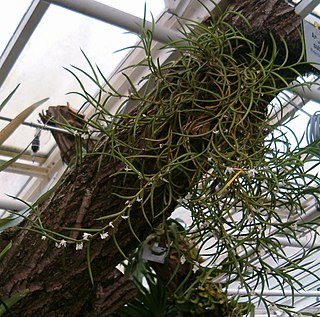Angraecopsis tridens is a species of plant in the family Orchidaceae. It is found in Cameroon and Equatorial Guinea. Its natural habitats are subtropical or tropical moist lowland forests and subtropical or tropical moist montane forests. It is threatened by habitat loss.

Angraecum sanfordii is a species of plant in the family Orchidaceae. It is endemic to Cameroon, where it occurs on Mount Kupe and Mount Cameroon. It grows in submontane and montane habitat types. It is an epiphyte. It is threatened by habitat loss.
Bulbophyllum micropetalum is a species of plant in the family Orchidaceae. It is found in Cameroon and the island of Bioko in Equatorial Guinea. Its natural habitat is subtropical or tropical moist montane forests. It is threatened by habitat loss.

Calyptrochilum aurantiacum is a plant species in the family Orchidaceae. It is endemic to Cameroon. Its natural habitat is subtropical or tropical moist lowland forests. It is threatened by habitat loss.
Polystachya kupensis is a species of plant in the family Orchidaceae. It is endemic to Cameroon. Its natural habitat is subtropical or tropical moist lowland forests. It is threatened by habitat loss.

Angraecum distichum is a species of comet orchid that is found across sub-Saharan and tropical Africa.

Cyrtorchis is a genus of flowering plants from the orchid family Orchidaceae native to Africa.
Angraecum aporoides is a species of comet orchid that can be found in Burundi, Cameroon, the Democratic Republic of the Congo, Equatorial Guinea, Gabon, Nigeria, Rwanda and São Tomé and Principe. It can be found in dense lowland forest from elevations of 20–2,400 m on Gilbertiodendron dewevrei trees.
Angraecum atlanticum is a species of comet orchid that can be found in Equatorial Guinea and Gabon. It is known from three subpopulations; in Monte Alén National Park in Equatorial Guinea and in Moukalaba-Doudou National Park and Ivindo National Park in Gabon. It is found in epiphyte-rich submontane forest, and in the shrubby fringes rich in Burseraceae.
Angraecum bancoense is a species of comet orchid that can be found in Cameroon, the Central African Republic, the Republic of the Congo, the Democratic Republic of the Congo, Equatorial Guinea, Gabon, Ghana, Guinea, Liberia, Nigeria, Rwanda, São Tomé and Principe and Sierra Leone. It can be found with Calamus, on Lophira alata, Macrolebium or Blighia welwitschii.
Angraecum doratophyllum is a species of comet orchid that is endemic to São Tomé and Príncipe. On São Tomé, it can be found from elevations of 850–1,600 m, growing with Syzygium guineense or with Bulbophyllum lizae. On Príncipe, it is found in shrubby vegetation at around 300 m elevation. It is threatened by deforestation for agriculture and timber.
Angraecum gabonense is a species of comet orchid that can be found in Cameroon, the Democratic Republic of the Congo, Equatorial Guinea and Gabon.

Angraecum podochiloides is a species of comet orchid that can be found in Cameroon, the Democratic Republic of the Congo, Côte d'Ivoire, Equatorial Guinea, Gabon, Ghana, Liberia and Nigeria. It can be found in dense lowland forests on Gilbertiodendron dewevrei, and in humid forests at higher elevations or low montane forests. It is an epiphyte on Dialium corbisieri or in periodically flooded marshes with Guibourtia.
Angraecum pungens is a species of comet orchid that can be found in Cameroon, the Democratic Republic of the Congo, Equatorial Guinea, Gabon and Nigeria. It is found in dense lowland forests, downstream from waterfalls, and on periodically flooded marshes with Oxystigma mannii, between elevations of 50–1,800 m. It also occurs on Terminalia catappa. It is threatened by habitat loss from agriculture and logging.

Angraecum subulatum is a species of comet orchid that can be found in Cameroon, the Democratic Republic of the Congo, Côte d'Ivoire, Equatorial Guinea, Gabon, Ghana, Guinea, Liberia, Nigeria and Sierra Leone. This species is found in lowland forests, especially those rich in Caesalpinioideae between 50 and 700 m elevation. It occurs in periodically inundated swampy forests with Raphia, Pandanus and Marantaceae, and on calcareous rock in shrubby vegetation. It has been recorded on high shaded branches of Gilbertiodendron dewevrei.
Erythrophleum ivorense is a species of leguminous tree in the genus Erythrophleum found in the rainforests of tropical West and Central Africa. The tree has many uses; the timber is used for heavy construction, for making charcoal and for firewood, the bark is used for tanning and in traditional medicine, and both bark and seeds are poisonous and used for hunting.

Brachystegia laurentii, a plant in the family Fabaceae, is a species of large tree found in western Cameroon, Gabon, Equatorial Guinea, the Democratic Republic of the Congo and the Republic of the Congo. It has a dense, umbrella-shaped crown. The wood is known as bomanga and has many uses in building and construction.
Julbernardia seretii, commonly known as the Congo zebrawood, is a species of legume in the family Fabaceae. It is found in tropical West and Central Africa.
Parkia bicolor, the African locust-bean, is a species of flowering plant, a tree in the family Fabaceae. It is native to tropical West and Central Africa. Its natural habitats are tropical moist lowland forests, swampland, woodland and savannah.
Polystachya bifida is a species of flowering plant in the family Orchidaceae, native from south-east Nigeria to west-central tropical Africa. It was first described by John Lindley in 1862.








